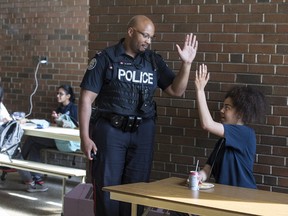
Is there a place for police in Toronto high schools?
The subject recently came up again after York Memorial Collegiate Institute was in the news over reports of chaos in the school: massive brawls in the hallway, bathrooms used for drug deals and fights, and teachers being threatened and assaulted.
As the Canadian national soccer teams head to their respective FIFA World Cups, Derek Van Diest is on the scene to cover all the action. Expect expert insights and analysis in your inbox daily throughout the tournaments, and weekly on Thursdays for the rest of the season.
Thanks for signing up!
A welcome email is on its way. If you don't see it, please check your junk folder.
The next issue of Corner Kicks with Derek Van Diest will soon be in your inbox.
A rash of violent incidents in schools recently prompted a former police officer, Scott Mills, to ask Mayor John Tory to think about reinstating the School Resource Officer (SRO) program.
That program ended in 2017, with some groups saying “good riddance” and others decrying the loss of what had been viewed as a successful initiative.
Would the Toronto District School Board (TDSB) consider a return to the SRO program?
A TDSB spokesperson said in a statement last week, “We don’t believe a return to the SRO program is the answer for either organization.
“However, as schools are part of communities, it is important that we have a relationship with police in order to address urgent safety concerns.”
But what should that relationship look like?
The TDSB emphasis on community rather than school echoes something Scott Mills said about the SRO program — that it was all about community in the beginning, and less about the schools.
A handful of cops on bikes were present in the community, they got to know the kids quite well, and they worked on intervention and prevention. As Mills put it, “we weren’t that interested in arresting anyone.”
By the time the SRO initiative expanded to 45 of 113 high schools, the mandate seemed to have changed. Now it was officers assigned to specific schools. It was not as effective.
Recommended video
The program began after the 2007 death of Jordan Manners,15, who was shot to death at C.W. Jefferys Collegiate Institute — the first time a student had ever been murdered inside a Toronto school.
Manners’ mother, Loreen Small, was in favour of the SRO program.
By 2017, however, the program was ended by TDSB trustees amid calls for police reform and accusations of systemic racism.
What do the police think the arrangement should be with schools?
Jon Reid, president of the Toronto Police Association, began a recent statement by listing the positive outcomes of the SRO program.
The officers, he said, “were embedded in the school community and took a leadership role in running programs such as anti-bullying, music, sports, community outreach initiatives, restorative justice circles, tutoring, and breakfast clubs.
“We cannot be the only solution to the issue,” he added. “School boards must consider — what drives a young person to take a weapon to school in the first place?
“What is the environment in which a young person feels they can even bring a weapon to school?
“What has happened that any behaviour warranting a police response has been allowed to escalate?”
As far as Mills is concerned, something needs to be put together between the schools and the police, if only to restore a crucial communication network. Being, “out and about where the kids congregate,” said Mills, helps police keep on top of trouble before it happens.
“It helps us know where to be and when to be there.”
Several recent violent incidents at Toronto schools, he added, were predictable in a way.
There would have been indications beforehand that something was up. Someone in the community or something on social media would have alerted police or school officials.
With School Resource Officers in place, an intervention at a community level would have been far more likely; without them, there’s a gap in the information chain.
Said Mills: “Maybe they need to replicate the neighbourhood policing program at the schools. Put more police in the neighbourhood and task them with the schools.”
What would SRO have done about York Memorial, where teachers say all the trouble is caused by a handful of students?
“We’d have been trying to engage those kids in other activities, even if it was just playing basketball,” said Mills.
“People will say, ‘Playing basketball?!’ Well, yeah — it means a cop is not chasing those kids down the street with a gun. I’d call that a win.”


